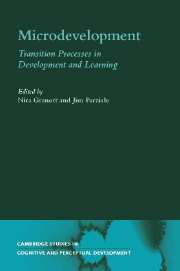Book contents
- Frontmatter
- Contents
- List of figures
- List of tables
- List of contributors
- Microdevelopment: A process-oriented perspective for studying development and learning
- Part I Variability
- Part II Transition mechanisms
- Part III Micro- and macrodevelopment
- 7 Interacting time scales in personality (and cognitive) development: Intentions, emotions, and emergent forms
- 8 How microdevelopment creates macrodevelopment: Reiterated sequences, backward transitions, and the Zone of Current Development
- 9 Macro- and microdevelopmental research: Assumptions, research strategies, constraints, and utilities
- Part IV Context
- Author index
- Subject index
- References
8 - How microdevelopment creates macrodevelopment: Reiterated sequences, backward transitions, and the Zone of Current Development
Published online by Cambridge University Press: 22 September 2009
- Frontmatter
- Contents
- List of figures
- List of tables
- List of contributors
- Microdevelopment: A process-oriented perspective for studying development and learning
- Part I Variability
- Part II Transition mechanisms
- Part III Micro- and macrodevelopment
- 7 Interacting time scales in personality (and cognitive) development: Intentions, emotions, and emergent forms
- 8 How microdevelopment creates macrodevelopment: Reiterated sequences, backward transitions, and the Zone of Current Development
- 9 Macro- and microdevelopmental research: Assumptions, research strategies, constraints, and utilities
- Part IV Context
- Author index
- Subject index
- References
Summary
What creates development? This question has intrigued researchers for centuries. Traditional cross-sectional and longitudinal methods, which compare abilities at specific points in time, capture global developmental trends. However, these methods cannot explain how development occurs, because the mechanisms and patterns that underlie development are manifested in the developmental process, not at single points in time. By contrast, on-line activity within context can capture transitions and change. On-line activity that evolves is called microdevelopment – i.e., development during short time spans (usually ranging from minutes and hours to weeks or a few months). By giving access to the developmental process, analysis of microdevelopment can identify developmental patterns that suggest how development occurs.
This chapter describes a developmental model that relates micro- and macrodevelopment. The model suggests that development evolves through reiterated microdevelopmental sequences (Granott, 1993a). Each sequence develops within a specific context. Three types of variability operate within and across sequences. (1) Backward transitions that form temporary regressions followed by progress. (2) Ordered fluctuations, bounded within a developmental range – a Zone of Current Development (ZCD). (3) Reiteration of processes. The three processes have several functions that promote developmental progress. The attributes of the model are demonstrated by a study on the microdevelopment of adults' scientific inquiry.
Process-oriented approaches: A new view of development
Most developmental theories describe development as a series of stages, each building on the achievements of previous ones. Traditional theories link stages to age. Within a stage, the underlying abilities are considered as even.
- Type
- Chapter
- Information
- MicrodevelopmentTransition Processes in Development and Learning, pp. 213 - 242Publisher: Cambridge University PressPrint publication year: 2002
References
- 23
- Cited by



